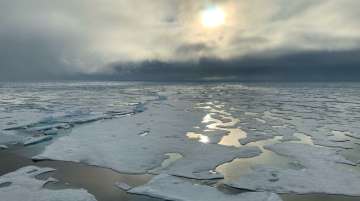A German icebreaker carrying scientists on a year-long international expedition in the high Arctic has reached the North Pole, after making an unplanned detour there due to lighter-than-usual sea ice conditions.
Expedition leader Markus Rex said Wednesday the RV Polarstern was able to reach the geographic North Pole because of large openings in sea ice above Greenland, where shipping would normally be too difficult.
“We made fast progress in a few days,” Rex told The Associated Press. “It’s breathtaking — at times we had open water as far as the eye could see.”
The region above northern Greenland is usually covered in thick sea ice, sometimes built up over several years, that makes it difficult even for ships with hardened hulls to break through. But the Polarstern was able to make it from the ice edge in the Fram Strait to the pole in less than a week, Rex said.
The mushy ice conditions the Polarstern encountered this year provide further evidence of the warming that scientists say is taking place in the Arctic.
The MOSAiC expedition involves scientists from 17 nations, including the United States, France, Russia and China. It sailed from the Norwegian port of Tromsoe last September, anchored to an ice floe and conducted numerous experiments to study the impact of climate change on the planet’s far north until the summer heat broke apart the ice cover.
The coronavirus pandemic almost caused the mission to be cut short, as travel restrictions made resupply and crew rotations difficult. But expedition organizers at Germany’s Alfred Wegener Institute for Polar and Ocean Research found a way around the logistical hurdles that involved just a brief break from the ice.
After passing the pole, the Polarstern will anchor to a newly formed floe and observe the start of the freezing process that will see the Arctic covered once more in a mantle of sea ice.
The 100 crew and scientists plan to return to Bremerhaven, Germany, on Oct. 12.
